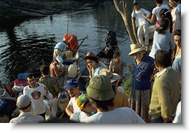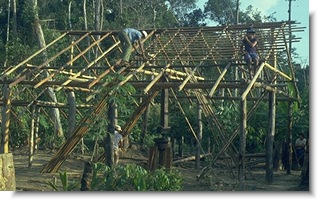|
|



  
Céu do Mapiá - The Community Project Rio Branco is the capital of Acre State. In the end of 70’s, a
new batch of southern immigrants and cattle ranchers arrived in this remote area,
attracted by the government financial incentives and the opening of the highway BR 364, a
road that links the jungle of the western Amazon to the industrialized south of Brazil. In
January 1983, a group of rubber tappers and land workers of the neighboring areas of Rio
Branco, started to feel threatened by the continuous anarchic growth of the urban
outskirts of Rio Branco. They required, through the Brazilian Government, a piece of land
in the interior or the Amazon rainforest, where they could organize a self-sustainable
community seeking for a conservation policy of the forest. Rio Branco is the capital of Acre State. In the end of 70’s, a
new batch of southern immigrants and cattle ranchers arrived in this remote area,
attracted by the government financial incentives and the opening of the highway BR 364, a
road that links the jungle of the western Amazon to the industrialized south of Brazil. In
January 1983, a group of rubber tappers and land workers of the neighboring areas of Rio
Branco, started to feel threatened by the continuous anarchic growth of the urban
outskirts of Rio Branco. They required, through the Brazilian Government, a piece of land
in the interior or the Amazon rainforest, where they could organize a self-sustainable
community seeking for a conservation policy of the forest.
 In our days the village of Céu do Mapiá, situated in the headwaters of the
river stream of Mapiá, tributary of the Purus River, in the municipality of Pauiní,
concentrate 700 inhabitants, dedicated to agriculture and extractive activities. In our days the village of Céu do Mapiá, situated in the headwaters of the
river stream of Mapiá, tributary of the Purus River, in the municipality of Pauiní,
concentrate 700 inhabitants, dedicated to agriculture and extractive activities. |
 |
 The community has 200 dwellings, one school, one church, one
medical-odontological post, warehouses, many canoes and motor boats, an arts and crafts
center, a joinery, house of herbs and pharmaceutical native plants, vegetable gardens and
one community kitchen. The community has 200 dwellings, one school, one church, one
medical-odontological post, warehouses, many canoes and motor boats, an arts and crafts
center, a joinery, house of herbs and pharmaceutical native plants, vegetable gardens and
one community kitchen.
 Following a report written in 1991 by IBAMA (Brazilian Governmental
Environment Agency), they concluded that the community of Céu do Mapiá acquired a much
higher standard of living than most of the other traditional or recent settlements in the
Amazon. As it was commented in the report: Following a report written in 1991 by IBAMA (Brazilian Governmental
Environment Agency), they concluded that the community of Céu do Mapiá acquired a much
higher standard of living than most of the other traditional or recent settlements in the
Amazon. As it was commented in the report:
"...the
health and living conditions of the people settled in the community Céu do Mapiá is much
higher than its neighbours of the margins of Purus and Juruá rivers and many others
around the Amazon region, and even better than many urban areas of the large in the south
of Brazil...".
 Although, the village of Mapiá is not yet exempt of tropical
endemic diseases of the Amazon rainforest such as malária, leishmaniose, hepatitis and
many types of verminosis. Some skin problems, producing horrible itches such as
mosquito’s bite, and arachnids are easily healed by the local medical post, as well
as snakes bites. But for other serious diseases, the medical post is still unsatisfactory.
Nevertheless the medical post of Mapiá is essential for the continuous progress of the
community. We need to establish more national and international
agreements to prevent the diseases and to be able to heal "in loco" most of
the diseases, establishing programs of sanitary education. Although, the village of Mapiá is not yet exempt of tropical
endemic diseases of the Amazon rainforest such as malária, leishmaniose, hepatitis and
many types of verminosis. Some skin problems, producing horrible itches such as
mosquito’s bite, and arachnids are easily healed by the local medical post, as well
as snakes bites. But for other serious diseases, the medical post is still unsatisfactory.
Nevertheless the medical post of Mapiá is essential for the continuous progress of the
community. We need to establish more national and international
agreements to prevent the diseases and to be able to heal "in loco" most of
the diseases, establishing programs of sanitary education.
 In the other hand, alcoholism and other toxic dependency are totally
absent of the village, There are not single case of malnutrition, which is very common in
most of the areas outside and around The National Forest of Purus and
Mapiá-Inauiní. The village was to organize a communitary pattern of plantation,
harvest and distribution of food. In the other hand, alcoholism and other toxic dependency are totally
absent of the village, There are not single case of malnutrition, which is very common in
most of the areas outside and around The National Forest of Purus and
Mapiá-Inauiní. The village was to organize a communitary pattern of plantation,
harvest and distribution of food.
 The houses of Mapiá are elaborated, confortable and cleaner than the most of
Amazonian buildings, built all in wood and the roofs are covered with zinc or splinters of
wood. Nevertheless, it should be given a particularly attention on the sanitary
conditions, such as dry organic sanitary disposal units and fresh water distribution and
sewage. The houses of Mapiá are elaborated, confortable and cleaner than the most of
Amazonian buildings, built all in wood and the roofs are covered with zinc or splinters of
wood. Nevertheless, it should be given a particularly attention on the sanitary
conditions, such as dry organic sanitary disposal units and fresh water distribution and
sewage. |
 |
 Most of the buildings have plenty of clean water at their disposal, obtained
from spring sources or artesian wells. But with the increase of the population, this clean
water is contaminated by soaps, excremental matters and the oils from the canoes,
contributing to the pollution of the river stream and producing serious verminosis or
other types of diseases. A more adequate care with the water seems to be one of the major
priorities for Céu do Mapiá. Nevertheless, the sanitary improvements will only be
achieved if followed by a serious education program. In the last few months many cases of
verminosis were detected in the village but some at the patients only found satisfactory
treatments in Boca do Acre, the largest town, two full days away from Céu do Mapiá. Most of the buildings have plenty of clean water at their disposal, obtained
from spring sources or artesian wells. But with the increase of the population, this clean
water is contaminated by soaps, excremental matters and the oils from the canoes,
contributing to the pollution of the river stream and producing serious verminosis or
other types of diseases. A more adequate care with the water seems to be one of the major
priorities for Céu do Mapiá. Nevertheless, the sanitary improvements will only be
achieved if followed by a serious education program. In the last few months many cases of
verminosis were detected in the village but some at the patients only found satisfactory
treatments in Boca do Acre, the largest town, two full days away from Céu do Mapiá.
 Few years ago, 40 kits solar energy from Europe were donated to the
community. It is certainly one of most useful individual equipment of the village. Mapiá
will need to get more of those energy sources. Many buildings now have non polluting,
inexpensive energy source extracted from the solar plates. But in the other hand, energy
supply for machines is still very scarce. One generator of 24Kw is the only source of
energy for the joinery, other important sector of the economy of the village. The medical
post, for instance needs to acquire its own generator or any other type or alternative
source of energy supply, as soon as possible. Few years ago, 40 kits solar energy from Europe were donated to the
community. It is certainly one of most useful individual equipment of the village. Mapiá
will need to get more of those energy sources. Many buildings now have non polluting,
inexpensive energy source extracted from the solar plates. But in the other hand, energy
supply for machines is still very scarce. One generator of 24Kw is the only source of
energy for the joinery, other important sector of the economy of the village. The medical
post, for instance needs to acquire its own generator or any other type or alternative
source of energy supply, as soon as possible.
 The village has one primary school with more than 100 students, with
courses on agriculture techniques, house construction and art work as well. The education
sector needs then a very special attention. More investments, more projects and more national and international support in order to lead, the children
and adults, towards a full successful experience of self-sustainable development in the
rainforest. Most of the environment awareness should be acquired in the school. Sanitary
methods, healthy care, and art works adequate to its environment, should also be
encouraged. But one major difference between Céu do Mapiá and other communities in this
area of the Amazon, is a large number of immigrants with university studies who are
teachers in the School Cruzeiro do Sul. These people, most of then southern areas of
Brazil: Rio de Janeiro, Minas Gerais, São Paulo, Rio Grande do Sul, Brasilia (DF), and
Paraíba, are forest engineers, geographers, physicians, dentist, teachers, journalists,
sociologists, anthropologists and lawyers, etc. But there are still a lot to do in this
field and that’s one of the other main priority for the future of the National
Forest. The village has one primary school with more than 100 students, with
courses on agriculture techniques, house construction and art work as well. The education
sector needs then a very special attention. More investments, more projects and more national and international support in order to lead, the children
and adults, towards a full successful experience of self-sustainable development in the
rainforest. Most of the environment awareness should be acquired in the school. Sanitary
methods, healthy care, and art works adequate to its environment, should also be
encouraged. But one major difference between Céu do Mapiá and other communities in this
area of the Amazon, is a large number of immigrants with university studies who are
teachers in the School Cruzeiro do Sul. These people, most of then southern areas of
Brazil: Rio de Janeiro, Minas Gerais, São Paulo, Rio Grande do Sul, Brasilia (DF), and
Paraíba, are forest engineers, geographers, physicians, dentist, teachers, journalists,
sociologists, anthropologists and lawyers, etc. But there are still a lot to do in this
field and that’s one of the other main priority for the future of the National
Forest. |
|
|